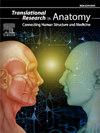Morphometric analysis of circulus arteriosus cerebri variations in a South African cadaveric sample
Q3 Medicine
引用次数: 0
Abstract
Introduction
The circulus arteriosus cerebri (CAC), or Circle of Willis, exhibits significant anatomical variability, with fewer than 50 % of cases displaying the conventional configuration. CAC variations are associated with intracranial aneurysm (IA) formation and subsequent haemorrhagic stroke. Due to limited data on CAC variations in South Africa, this study aimed to assess the prevalence and types of arterial variations in a South African cadaveric sample and to document associated IAs.
Methods
This retrospective, cross-sectional and quantitative study had a sample size of 64. The CAC was dissected, removed from the base of the brain, photographed, and analysed morphologically. Variations were classified using the Ayre et al. (2021) system and recorded individually.
Results
The intact samples (n = 40) were classified according to Ayre et al. (2021) and 22.5 % of the sample displayed the conventional configuration. The predominant pattern of variation was group 5 (miscellaneous patterns), and variations were commonly observed in both the anterior and posterior circulations (55 %). Individual variations were observed (n = 64 brains; 81 variations). The leading variations were unilateral posterior communicating artery (PcoA) hypoplasia (17.3 %) and aplasia (14.8 %). The anterior communicating artery (AcoA) was the most variable artery (44.4 %), with short fusion of the anterior cerebral arteries (ACAs) being the most common variation (13.6 %) affecting the AcoA. Rare findings include type 4 and 5 PcoA terminations (double P2), not previously reported in South Africa. IA frequency was insufficient for analysis.
Conclusions
These variations may increase stroke and IA risk. Knowledge of CAC variations can support neurosurgical planning and execution. Further studies in a South African setting are recommended.
南非尸体样本中脑动脉循环变异的形态计量学分析
脑动脉环(CAC),或称威利斯环,具有明显的解剖变异性,只有不到50%的病例显示常规形态。CAC变异与颅内动脉瘤(IA)形成和随后的出血性中风有关。由于南非CAC变异的数据有限,本研究旨在评估南非尸体样本中动脉变异的患病率和类型,并记录相关的IAs。方法回顾性、横断面、定量研究,样本量64例。解剖CAC,从颅底取出,拍照,并进行形态学分析。使用Ayre等人(2021)的系统对变异进行分类,并单独记录。结果完整样本(n = 40)按照Ayre et al.(2021)分类,22.5%的样本显示常规配置。变异的主要模式是第5组(杂项模式),变异通常在前循环和后循环中观察到(55%)。观察到个体差异(n = 64个大脑;81变化)。单侧后交通动脉(PcoA)发育不全(17.3%)和发育不全(14.8%)居首。前交通动脉(AcoA)是最易变的动脉(44.4%),大脑前动脉(ACAs)的短融合是影响AcoA最常见的变异(13.6%)。罕见的发现包括4型和5型PcoA终止(双P2),以前未在南非报道。IA频率不足以进行分析。结论这些变异可能增加卒中和IA风险。了解CAC的变化可以支持神经外科的计划和执行。建议在南非进行进一步的研究。
本文章由计算机程序翻译,如有差异,请以英文原文为准。
求助全文
约1分钟内获得全文
求助全文
来源期刊

Translational Research in Anatomy
Medicine-Anatomy
CiteScore
2.90
自引率
0.00%
发文量
71
审稿时长
25 days
期刊介绍:
Translational Research in Anatomy is an international peer-reviewed and open access journal that publishes high-quality original papers. Focusing on translational research, the journal aims to disseminate the knowledge that is gained in the basic science of anatomy and to apply it to the diagnosis and treatment of human pathology in order to improve individual patient well-being. Topics published in Translational Research in Anatomy include anatomy in all of its aspects, especially those that have application to other scientific disciplines including the health sciences: • gross anatomy • neuroanatomy • histology • immunohistochemistry • comparative anatomy • embryology • molecular biology • microscopic anatomy • forensics • imaging/radiology • medical education Priority will be given to studies that clearly articulate their relevance to the broader aspects of anatomy and how they can impact patient care.Strengthening the ties between morphological research and medicine will foster collaboration between anatomists and physicians. Therefore, Translational Research in Anatomy will serve as a platform for communication and understanding between the disciplines of anatomy and medicine and will aid in the dissemination of anatomical research. The journal accepts the following article types: 1. Review articles 2. Original research papers 3. New state-of-the-art methods of research in the field of anatomy including imaging, dissection methods, medical devices and quantitation 4. Education papers (teaching technologies/methods in medical education in anatomy) 5. Commentaries 6. Letters to the Editor 7. Selected conference papers 8. Case Reports
 求助内容:
求助内容: 应助结果提醒方式:
应助结果提醒方式:


